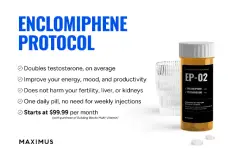madman
Super Moderator
As always bringing you the latest and greatest.....Nelson's house is where it's at!
Leaving everyone in the dust here!
Time to purge!
* These results suggest it may be beneficial to start men at a higher starting dose of TU than the approved dosing regimen to minimize multiple time-intensive dose titrations and allow patients to reach therapeutic T levels in a more timely manner. Future studies should aim to evaluate patient-specific variables to determine which patients would benefit from starting at higher TU doses initially to guide clinician management of hypogonadism.

RESULTS OF PREDICTABLE UP TITRATION OF ORAL TESTOSTERONE UNDECANOATE IN A PHASE 3 RANDOMIZED TRIAL
Helen L. Bernie*, Indianapolis, IN; Lena Yoo, Zuzanna Szmukier,Deborah M. Boldt-Houle, Buffalo Grove, IL
INTRODUCTION AND OBJECTIVE:
>2.4 million US men have hypogonadism, defined as a serum testosterone (T) level<300 ng/dL with symptoms of T deficiency. Hypogonadism can result in the development of metabolic syndrome, increased risk of coronary artery disease, decreased libido, low bone mineral density, and muscle loss. While oral testosterone therapies provide a route of administration that may be more appropriate for some patients’ needs, effective dose titration remains a key challenge for clinicians as they often need to titrate multiple times for patients to achieve target T levels which is labor-intensive. Herein, we present secondary analyses of post-titration changes in T levels from the phase 3 inTUNE study of oral titratable testosterone undecanoate (TU).
METHODS
A phase 3, randomized, active controlled, open-label study assessed the safety and efficacy of oral TU (approved in 158, 198, 237, 316, and 396 mg doses) in 166 hypogonadal men. The initial oral TU dose was 237 mg TU twice a day, which is the approved starting dose. Patients were allowed to titrate up on Days 35 and 70 if their 24-hr average T concentration on Days 21 and 56 was<350 ng/dL. Serum T measurements were taken before and after each titration adjustment (Days 21, 56 and 105, respectively) at 2, 4, 6, 9, 12, 14, 16, 18, 21 and 24 hours after the morning TU dose. Serum T at 4-hr post dose was analyzed in this secondary analysis.
RESULTS
A total of 116 patients required up-titration based on 24-hr average T levels below 350 ng/dL on the standard dosing of TU, resulting in 174 up-titration events. On average, up-titration from 237 to 316 mg and from 316 to 396 mg resulted in a mean of 192 and 185 ng/dL rise in T at the 4-hr post dose, respectively (Fig 1). 34% and 41% of patients required 1 and 2 titrations, respectively.
CONCLUSIONS
Patients observed a mean serum T increase of around 190 ng/dL with up-titrations from 237 to 316 mg and from 316 to 396 mg. Around 75% of patients required 1-2 titrations to reach therapeutic T levels. These results suggest it may be beneficial to start men at a higher starting dose of TU than the approved dosing regimen to minimize multiple time-intensive dose titrations and allow patients to reach therapeutic T levels in a more timely manner. Future studies should aim to evaluate patient-specific variables to determine which patients would benefit from starting at higher TU doses initially to guide clinician management of hypogonadism.
Leaving everyone in the dust here!
Time to purge!
* These results suggest it may be beneficial to start men at a higher starting dose of TU than the approved dosing regimen to minimize multiple time-intensive dose titrations and allow patients to reach therapeutic T levels in a more timely manner. Future studies should aim to evaluate patient-specific variables to determine which patients would benefit from starting at higher TU doses initially to guide clinician management of hypogonadism.
RESULTS OF PREDICTABLE UP TITRATION OF ORAL TESTOSTERONE UNDECANOATE IN A PHASE 3 RANDOMIZED TRIAL
Helen L. Bernie*, Indianapolis, IN; Lena Yoo, Zuzanna Szmukier,Deborah M. Boldt-Houle, Buffalo Grove, IL
INTRODUCTION AND OBJECTIVE:
>2.4 million US men have hypogonadism, defined as a serum testosterone (T) level<300 ng/dL with symptoms of T deficiency. Hypogonadism can result in the development of metabolic syndrome, increased risk of coronary artery disease, decreased libido, low bone mineral density, and muscle loss. While oral testosterone therapies provide a route of administration that may be more appropriate for some patients’ needs, effective dose titration remains a key challenge for clinicians as they often need to titrate multiple times for patients to achieve target T levels which is labor-intensive. Herein, we present secondary analyses of post-titration changes in T levels from the phase 3 inTUNE study of oral titratable testosterone undecanoate (TU).
METHODS
A phase 3, randomized, active controlled, open-label study assessed the safety and efficacy of oral TU (approved in 158, 198, 237, 316, and 396 mg doses) in 166 hypogonadal men. The initial oral TU dose was 237 mg TU twice a day, which is the approved starting dose. Patients were allowed to titrate up on Days 35 and 70 if their 24-hr average T concentration on Days 21 and 56 was<350 ng/dL. Serum T measurements were taken before and after each titration adjustment (Days 21, 56 and 105, respectively) at 2, 4, 6, 9, 12, 14, 16, 18, 21 and 24 hours after the morning TU dose. Serum T at 4-hr post dose was analyzed in this secondary analysis.
RESULTS
A total of 116 patients required up-titration based on 24-hr average T levels below 350 ng/dL on the standard dosing of TU, resulting in 174 up-titration events. On average, up-titration from 237 to 316 mg and from 316 to 396 mg resulted in a mean of 192 and 185 ng/dL rise in T at the 4-hr post dose, respectively (Fig 1). 34% and 41% of patients required 1 and 2 titrations, respectively.
CONCLUSIONS
Patients observed a mean serum T increase of around 190 ng/dL with up-titrations from 237 to 316 mg and from 316 to 396 mg. Around 75% of patients required 1-2 titrations to reach therapeutic T levels. These results suggest it may be beneficial to start men at a higher starting dose of TU than the approved dosing regimen to minimize multiple time-intensive dose titrations and allow patients to reach therapeutic T levels in a more timely manner. Future studies should aim to evaluate patient-specific variables to determine which patients would benefit from starting at higher TU doses initially to guide clinician management of hypogonadism.













